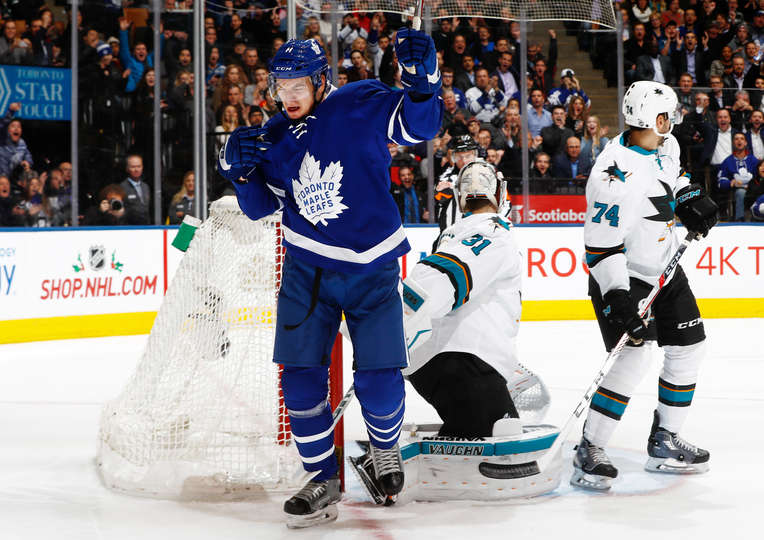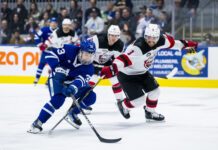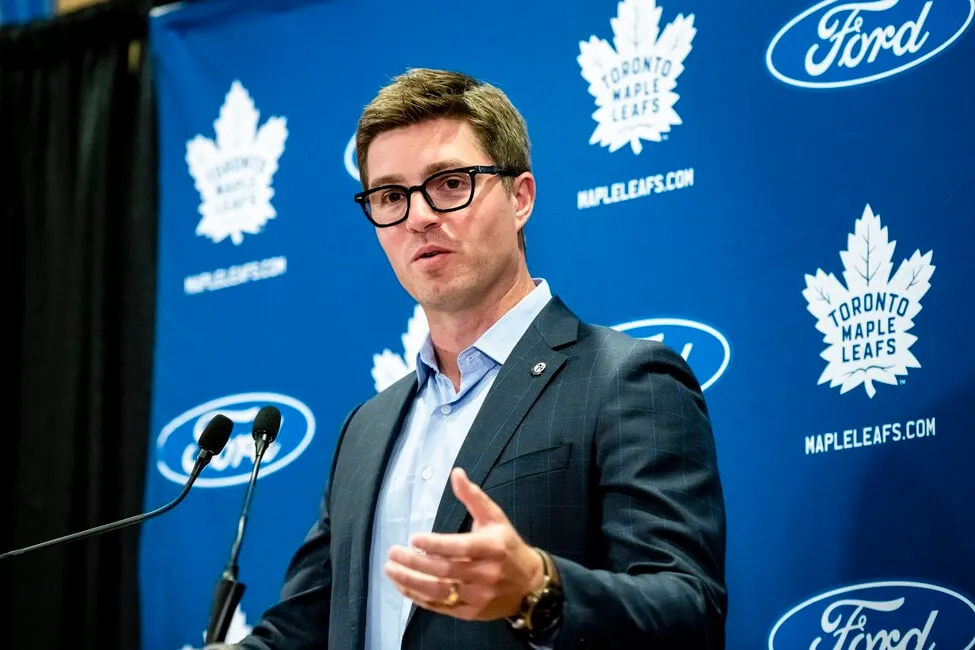Last we left off, we looked at the Toronto Maple Leafs’ forward depth and how they allocate their cap dollars. That presents the perfect segue into discussing the next steps for this roster, starting with the expansion draft.
First, a quick review of the parameters. The 30 teams included in the expansion draft have two options:
- Protect seven forwards, three defensemen, and one goalie
- Protect eight skaters (any combination of forwards/defensemen) and one goalie
There are a few other rules to keep in mind as well. All players who have accrued two or fewer professional seasons by the end of the 2020-21 season, as well as all unsigned draft choices appearing on a team’s reserve list, will be exempt.
Among the defensemen exposed to the draft, at least one must be under contract through 2021-22 and have played in at least 40 NHL games the prior season or played in at least 70 NHL games in the prior two seasons.
Teams also must expose two forwards who were under contract through 2021-22 and have played in at least 40 NHL games the prior season or played in at least 70 NHL games in the prior two seasons.
The first question for any team is which protection scheme to choose. While the prevailing wisdom around the Leafs is option B – any combination of eight forwards/defenseman — it should be noted that there are at least six forwards of consequence you would prefer (or, in most cases, not even discuss) losing for free:
- Auston Matthews
- Mitch Marner
- William Nylander
- John Tavares
- Alex Kerfoot
- Jason Spezza
Obviously, two of these players are not like the others, but you’d still rather not lose them for free. Realistically, let’s also be clear that Spezza will probably pull the “I’ll retire” card again — to say nothing of the fact that the Kraken would be crazy to claim a 38-year-old given their current position. Really, that just leaves Kerfoot in the pool of, “players the Leafs would rather not lose for free.”
On defense, there are five players in that camp:
- Morgan Rielly
- Jake Muzzin
- TJ Brodie
- Justin Holl
- Travis Dermott
Throughout the season, given his limited role, Dermott appeared destined to become an original member of the Kraken. The debate between him and Justin Holl is maybe not as cut and dry as it initially comes across given their respective roles on the team.
| Travis Dermott | Justin Holl | |
|---|---|---|
| Age | 24 (turns 25 in December) | 29 |
| Career games played | 208 | 136 |
| Career points per game | .23 | .3 |
| Career time on ice | 16:04 | 19:02 |
| Career Corsi (even strength) | 52.7 | 50.6 |
| Career Fenwick (even strength) | 52 | 51.3 |
| Career defensive zone start percentage (non neutral zone) | 45.4 | 53.2 |
Holl is four years older, and while he has played fewer games overall, any Leafs fan can tell you that he plays a bigger role in the lineup and has been more productive. But the four-year age gap, the fact that Dermott has actually played more games, Dermott flashing potential at times while moving higher up the lineup, and the fact that Dermott would come in cheaper than Holl on his next contract all make a case for Dermott to be retained as the eighth and final player while exposing Holl, who I’m not entirely positive would be claimed anyway.
The third pairing with Dermott and Bogosian was very solid this season — as was the Muzzin and Holl shutdown pairing, although it should be noted that playing with Muzzin makes any defender better.
What it really boils down to is that at age 29, Holl likely is what he is, even if he has played such a small number of games. There are always outliers you could compare him to, of course, but he has not exactly stood out when playing away from Muzzin. On the other hand, Dermott is still just 24 with over 200 games under his belt. He has shown promise multiple times when he has been moved up the lineup.
The floor is higher with Holl, but the ceiling is still higher with Dermott, and the latter should come at a cheaper cost.
That would leave Seattle with a choice that is between Alex Kerfoot and Justin Holl, unless they really wanted to claim Pierre Engvall. Claiming any of those players opens up at least a few dollars for the Leafs to play with (or in Kerfoot’s case, a good chunk of money).
There isn’t much need for the Leafs to overthink this or entice Seattle to claim one player over the next. You can justify leaving any of the above mentioned exposed, and should they get claimed, you simply move on and use the cap space left behind.
Zach Hyman Contract

Let’s talk about the pending Zach Hyman contract negotiation.
Over the last two seasons, the 29-year-old has put up 70 points in 94 regular-season games, including 36 goals. Those 36 goals tie Mitch Marner, Pavel Buchnevich, Matt Barzal and Ryan O’Reilly, and he played in at least 20 fewer games than all of them.
Of those goals, 29 of them came at even strength, tying him with players such as Mark Stone and Andrei Svechnikov. That is excellent company to be in — the type of production that gets a player paid, on top of what Hyman brings as a forechecker, a penalty killer, and his ability to play either wing (plus, he’s driven his own line at times).
Conversely, Hyman is 29 and has missed time due to injury in three straight seasons. He plays a style of hockey that traditionally does not age well and is more conducive to injury. This is the first year we’ve truly seen Hyman elevate weaker linemates versus riding shotgun with superstars. In his last 19 playoff games, Hyman has five points, so it’s not as if he has lit it up in crunch time, either.
In the Leafs Report podcast, Chris Johnston noted he believes that it would be highly unlikely that Hyman returns.
Perhaps in a flat cap market, the market isn’t so hot and Hyman ends up in a Tyler Toffoli situation (Toffoli, for the record, had 300 career points by the time he signed with the Habs, while Hyman has 185 career points. They both penalty kill, and one of them played a noteworthy top-six role while winning a Cup). Toffoli signed for four years at $4.25M per year — it’s pretty fair to say that anyone would take Hyman on that deal, but it doesn’t sound as if this will get a deal done. It sounds like Hyman’s number will start with a five and possibly rise towards a six.
Currently, CapFriendly shows the Leafs with 11.755M in cap space for next year with one goalie, five defensemen, and nine forwards signed. They need to fill out every group, improve their depth, and stabilize their goaltending. Of course, they will also lose someone to the expansion draft.
It’s often thought that a team is not really in cap trouble if it has contracts that are moveable. In the Leafs’ case, though, they aren’t planning on moving any of their big contracts save for maybe Morgan Rielly, so that does put them in cap trouble.
Space is tight, and they have a number of holes to fill. Failing a major move to make it all work, it’s difficult to see a fit where they sign Hyman, adequately fill out their roster, and actually improve the team.
What happened with the power play — and Mitch Marner?

When the playoffs ended, Ian Tulloch reported that Mitch Marner was unwilling to shift off the half-wall to play by the goal line on the power play in favour of William Nylander. Marner and his camp were quick to dismiss this report as untrue. I have no clue what to believe, and frankly, I’m not even sure if I care. No matter what the truth is, the common denominator is that the coaching staff is culpable.
On one hand, let’s assume that Marner was in fact unwilling to move to a different spot. There are a whole host of problems if this came from the player and his camp. Beyond that, it’s arguably even more problematic that the coaching staff acquiesced to the request. We live in an era where star players have more and more say in team matters (this would not be unique to Toronto — it’s happening league-wide). But if it’s to the detriment of the team as a whole and the coaching staff is still amenable to it, essentially, the inmates are running the asylum.
On the other hand, let’s assume that this conversation never happened and by extension, they did not look at moving him off of the half-wall. This is the obvious question, then: Why not?
From March 21 through to the end of the season (which was just about two months of real-time), the Leafs played 24 games and their power play scored five goals while surrendering five. It was clicking at 8.2% in that time, which nearly encompasses half of the shortened season.
In the playoffs, the Leafs scored three goals and gave up a game-winning shorthanded goal. Their 13% success rate would have ranked 29th over the course of the regular season. In the final three games of the series, the Leafs went 0/7, including an 0/4 game.
The Leafs’ three power-play goals? Two came off of the rush, and the other was William Nylander scoring… from the half-wall while Auston Matthews was on the other side.
There is no revisionist history at play here. What they were doing was not working for months. Perhaps it ultimately had nothing to do with Marner, but they ran the power play through him and didn’t dare to find out what it might look like without him for any notable stretch of time. At best, Marner and Matthews would switch sides, but the power play ran through Marner regularly, despite Marner not scoring a single power-play goal this season. The opposition simply sagged off of him.
The man advantage became really stagnant. Oftentimes, Leafs’ power plays largely consisted of their players getting to their spots and standing around. Even in a sport like basketball — where players have their shooting spots where they space out and stand — they still need a creator to initiate and move defenders around in order to create openings. Without the initial creator, everyone ends up standing around watching the shot clock tick down.
In a nutshell, that’s what happened on too many Leafs power plays.
They simply had no answers. It culminated in the playoffs with forcing Rasmus Sandin, who essentially hadn’t played for a year, into the playoff mix over a player that played all year on a good, established third pairing. Sandin showed some positive moments in the playoffs, but he was also the victim on a number of key goals against.
All of that is to say the coaching staff should be facing a ton of heat and needs to answer a number of questions about what happened here. To have all of this talent at their disposal and look as completely inept as they did for such a long period of time is incomprehensible.
If anything, it did the coaching staff a favour that Mitch Marner became the main storyline in the public debates.
A few quick hits

– I think one of the most damaging things that could come out of this Habs playoff run is a sudden about-face in perspective that now suggests everything is okay with the Leafs and they simply lost to a good opponent. There is a kernel of truth in it, but there are a few obvious things to note here.
The first is that they actually have to beat good teams to win the Cup – it is never a cakewalk, so it makes no sense to simply shrug it off. The second is that there were some fundamental issues that were exposed, and if the Habs didn’t finish the Leafs off, it’s likely someone else would have (the Leafs would have played Tampa Bay in the third round).
The Leafs’ center depth is shallow beyond the top two — maybe three, and that’s only because Kerfoot stepped up when Tavares went down. The team also lacks bottom-six production in general, as almost every forward down there was a non-factor.
The third is that special teams were — once again — a huge issue in the playoffs, and the coaching staff — once again — offered few answers. Their inability to make adjustments — both personnel-wise and tactically — has been a problem for two straight playoffs.
The Habs should receive a ton of credit for their run, but the Leafs can’t just simply chalk this up to losing to a good team and run it back again next year.
– I really like what Ilya Mikheyev brings with his speed and penalty killing, but he has zero points in his playoff career, and his inability to finish was honestly reaching comical heights during the season. Maybe the wrist fully heals and he flashes more of what he did as a rookie, but the Leafs can’t bank on it.
I actually went back and rewatched his eight goals from his rookie season – two were empty-net goals, two were empty-net tap-ins with a goalie in the net, one was beating Jimmy Howard in a race to the puck that resulted in scoring into an empty net, and one was a John Tavares shot Mikheyev tipped in that I’m not entirely sure he knew he was tipping at the time.
Mikheyev is a good penalty killer and checker, and I wouldn’t mind him back as a fourth-liner, but that’s about the extent of it. It’s difficult to have a player on the third line that is not even remotely a scoring threat of any kind, even if he does skate fast and is good on the penalty kill.
– It was a disappointing stint for Nick Foligno, who had a promising start before an injury derailed his season and playoff. It’s possible that the lack of production and performance has caused people to sour on him, but he has proven that he is a good player when healthy. In his first few games as a Leaf, he was fitting in nicely.
All the reasons the team acquired him in the first place – his versatility and two-way play chief among them — are still assets a healthy Foligno can bring to the table. The Leafs should be interested in retaining him if the number makes sense. He’s a good player and can play up and down their lineup in any role they ask him to.
– I recognize it will sound like I am talking out of both sides of my mouth after the previous, although I’d argue retaining Foligno doesn’t prohibit this much: A subtle thing that didn’t get much mention is the Leafs having less speed than years past. William Nylander and Alex Kerfoot stood out, in part, due to their speed. Mitch Marner has never been a burner and while Auston Matthews is a powerful skater, he isn’t exactly a speedster, either. Mikheyev and Engvall are both fast, although they struggle to do anything with the puck. That was basically it on the team.
After the Leafs traded away Kasperi Kapanen and Andreas Johnsson last offseason, the loss of speed wasn’t really evident during the season, but it was at playoff time.
– Can’t believe I am writing this, but we are now at the point where one can somewhat start thinking about Auston Matthews’ contract. There are three years left on it before he’s eligible to hit the open market. The team obviously has not had any playoff success whatsoever. Next year, the Leafs’ division becomes significantly more difficult. It’s not yet in the worrisome territory, but it’s creeping into the back of the mind a little bit now.


































